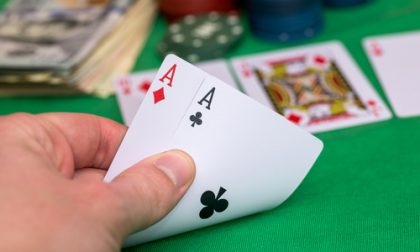Maria Ho Involved in Minor Hand Controversy at WSOP After Misunderstanding
Last week, we discussed a controversial hand at the end of a World Series of Poker final table that had poker pros and fans alike debating how to handle the situation. Earlier this week, we had another one and while this hand involving Maria Ho has not sparked the outrage that Sam Soverel’s did, it is still interesting to talk about. I said last week that I loved this stuff, so let’s keep me fueled up and go forth with it.
You’re Not Supposed to Do That at That Point
 The event was $1,000 Double Stack No-Limit Hold’em, a tournament in which everyone starts with 40,000 chips. It was the first day, so players were still trying to feel their way through the field of more than 3,200 entries.
The event was $1,000 Double Stack No-Limit Hold’em, a tournament in which everyone starts with 40,000 chips. It was the first day, so players were still trying to feel their way through the field of more than 3,200 entries.
Maria Ho had been doing very well early on, building her stack to about 130,000 chips. With blinds at 6,000/12,000 with a 12,000 chip ante, she raised pre-flop in the hand in question to 105,000, leaving just 25,000 chips behind. Clearly, she meant business (or was just trying to force a fold and win the pot right there, I suppose). Everybody folded to the player in the small blind who asked the dealer for a count of the bet, after which he made the call.
What happened next was that the flop was dealt and the hand continued like normal. Or not. After the small blind player made the call, both he and Ho turned over their hole cards. Ho still had 25,000 chips behind and both of them tabled their cards pre-flop. Yes.
Ho had A-J, the other player had Queens and the entire board was dealt out: J-2-T-A-6. Maria Ho won the hand and was paid… and that’s the question.
She thought that because both she and her opponent flipped over their cards pre-flop, she was not due 105,000 of her opponent’s chips, but 105,000 plus an additional 25,000. Her opponent had for some reason thought she was all-in, thus his tabling of his cards without hesitation. From all reports, it does not sound like Mario Ho had announced she was all in, nor was she concealing her stack of 25,000. It was simply a misunderstanding.
The floor ended up ruling that Ho was to be awarded the extra 25,000 because her opponent had accepted her action by calling and tabling his cards. At first blush, this may sound odd, especially since it feels like the easiest ruling would just be to award Ho 105,000 chips and be done with it. That they tabled their cards was just an unfortunate mistake that may or may not have affected the hand.
What Does the Rulebook Say?
There is no single rule in the official 2019 World Series of Poker rulebook for this situation, but a combination of rules may serve to be a guideline.
Rule 104:
104. Accepted Action: Poker is a game of alert, continuous observation. It is the caller’s responsibility to determine the correct amount of an opponent’s bet before calling, regardless of what is stated by the dealer or Participants. If a caller requests a count but receives incorrect information from the dealer or Participants, then places that amount in the pot, the caller is assumed to accept the full correct action & is subject to the correct wager or all-in amount.
Rule 105:
105. All-In with Chips Found Behind Later: If A bets all-in and a hidden chip is found behind after a Participant has called, the Event Tournament Director will determine if the chip behind is part of accepted action or not. If not part of the action, A will not be paid off for the chip(s) if he wins. If A loses he is not saved by the chip(s) and the Event Tournament Director may award the chip(s) to the winning caller.
Rule 70:
70. Face up for All-Ins: All cards will be turned face up once a Participant is all in and all betting action for the hand is complete. If a Participant accidentally folds/mucks their hand before cards are turned up, the Tournament Staff reserves the right to retrieve the folded/mucked cards if the cards are clearly identifiable.
Tie the Threads Together
Rule 104 certainly seems to be the most applicable here, though not exactly. Maria Ho’s opponent did not receive an incorrect count – he just assumed she was all-in. Rule 105 looks like it has to do with the floor deciding that Ho’s 25,000 chips left behind counted in her opponent’s call, but she never declared she was all-in, so that doesn’t exactly fit, either. The first sentence of Rule 70 may be where the implication that Ho was all-in comes from; both players turned their cards face up and for all intents and purposes, were done betting.
Combine all three rules and you have a player accepting an implied all-in bet because both players tabled their cards, the floor determining that Ho’s 25,000 were included, and the opponent accepting the action even though the correct all-in wager wasn’t made. Confusing, I know.
From a practical standpoint, one could easily say that an all-in by Maria Ho was implied considering how few chips she had left behind relative to her stack and the pot. If her opponent had called and neither of them tabled their cards, thus bringing on the flop, I’d bet my own figurative stack that Ho would have shoved the rest of her chips into the middle immediately and her opponent would have called. Thus, by tabling their cards pre-flop, they just skipped the post-flop mechanics (though it sounds like it was all still just a misunderstanding).
Some in the poker community have opined that it could have been an angle shot by Ho, as if she lost the hand, she could have argued that she wasn’t all-in and therefore should still have 25,000 chips left. There is no evidence to support that she had intended that – it was all likely a mistake – but such a gambit probably would have failed, anyway, as Rule 105 states that the all-in bettor is not saved by inadvertently leaving chips behind.



















COMMENTS